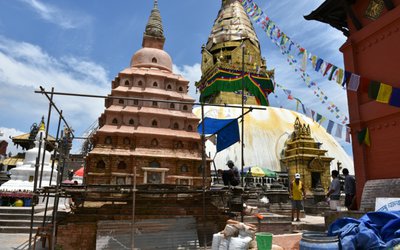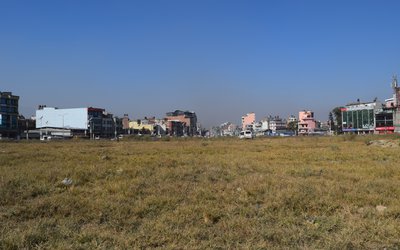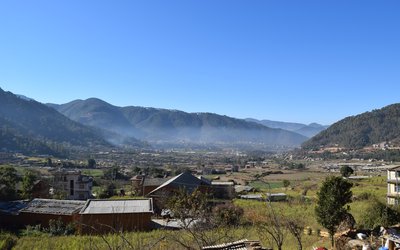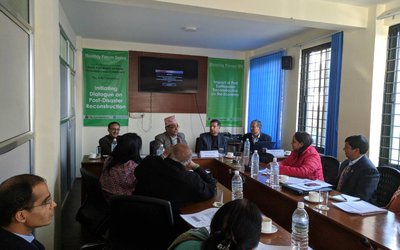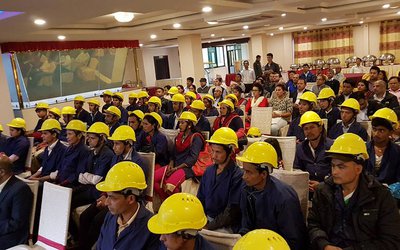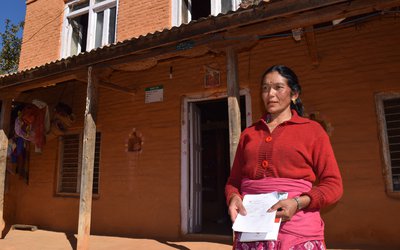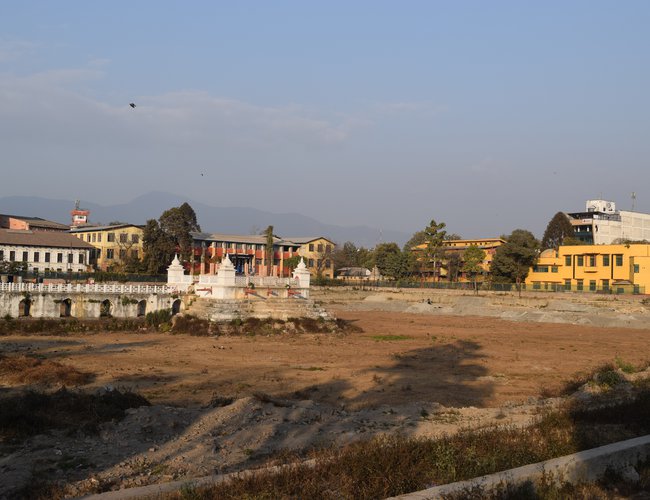
The sunset is closer but masons are still to get their routine respite from work at
Similarly, the reconstruction of temples and heritage sites in Patan and Bhaktapur is taking speed with the completion of work in a number of temples. However, work is not going the same way in Kathmandu.
Due to disputes on land, the construction modality and lack of coordination, the reconstruction of major heritage sites has landed in controversies. Following the order from Department of Archeology, the reconstruction of Ranipokhari has stopped until further notification.
Similarly, reconstruction of Kasthmandap is yet to take place due to the differences in opinions among the stakeholders and opposition of local community regarding reconstruction through the contractor and through tender. Many Rana Palaces, with historical significance, have been demolished
With the growing urbanization and increasing business activities, there is a wide demand for shopping complexes and recreational places. Located in the prime areas of the city, heritage sites have attracted land mafias as places to make money. Through the political connection and influence of money, land mafias are pulling the string from behind to destroy the essence of heritage sites.
With the complete backing of community and local level, heritage sites in Bhaktapur and Patan are well preserved. However, the situation is not the same with heritage sites of Kathmandu where there are wide differences among stakeholders.
The earthquake damaged 753 heritage sites and temples in 14 earthquake-affected districts. Out of this, 113 were completely damaged. According to National Reconstruction Authority, there were 250 temples damaged in Kathmandu, 130 in Patan and 80 in Bhaktapur. Till now, reconstruction of 79 heritage sites and temples has completed and there is progress in 314 heritage sites.
Demolition Fair
By benefits calculation, a project of demolition seems to be on a faster track than one of reconstruction. Once a municipality or other authority issues the order for demolition of a palace and heritage site, there is a rush to meet the work schedule. This is not so with reconstruction.
There is money to win contracts for demolition. Once they secure the contract, the contractor makes money by selling the most valuable old bricks, windows, wall paints, lights and wall paintings. After demolition, they again secure the contract for reconstruction.
This profit making process does not last here. Once they complete reconstruction, the contractor makes money in leasing out certain flats of buildings. “Since the demolition is a lifetime business to generate profit, contractors are rushing to politicians, encouraging them to take a decision to demolish the buildings,” said Ganapati Lal Shrestha, a Heritage Conservation Activist of Kathmandu. “In Ranipokhari, it is an open secret how a contractor used to make money from drying out the pond to construct a concrete wall around. He will charge now again for the demolition of the wall. What a good business.”
Rani Pokhari Controversy
In the name of beautification of Ranipokhari, a 350-year old heritage site in the heart of Kathmandu City, has already lost its face. A contractor released all the water of the pond to design the beautification of Ranipokhari, hoping to see the preservation of Kathmandu’s cultural jewels. However, when the water disappeared slowly, after the fish, and contractors started building a concrete pavilion and concrete wall around the pond, people smelled something was fishy.
Architectural engineer and cultural historian Sudarshan Raj Tiwari has been lobbying against building concrete structures at the site, arguing that doing so will reduce the historical heritage to a mere swimming pool.
“Rani Pokhari does not only hold the legacy of our rich culture and history but also helps maintain the underground water level. Therefore we must work to protect the pond in its traditional form,” said Tiwari.
However, engineer Ananta Ram Baidya described the idea of using black clay and traditional embankment as an ‘immature, hasty decision’ made by campaigners without adequate study.
Although the construction work has stopped now, activists and locals have been demanding that KMC scrap its plan to build an amusement park and a coffee shop and boating facility at the pond.
The Mayor of Kathmandu Metropolitan City (KMC) Bidhya Sundar Shakya holds the view that there is the need to money sustain the pond and preserve Ranipokhari. “The pond needs reconstruction as a place for recreation and beauty of Kathmandu.
The reconstruction has turned into a political tussle as stakeholders related to the reconstruction have been airing opposing views. Currently, the argument is whether the reconstruction of the historical pond would be carried out using traditional skills or modern technology.
Workers at the construction site used excavators to dig the mud out and construct the concrete wall. Experts believe that it damages the traditional water retaining system. The fishes of the pond were relocated to Balaju and Kamalpokhari.
Although the 25 April Earthquake had damaged only Balgopaleswor Temple located in the middle part of Ranipokhari, the water level of the pond remained intact. Pond lost its essence once the water was shocked out in the name of removing dirt and mud piled up in Ranipokhari. Experts hold the view that the contractor intentionally damaged the water retaining base of Ranipokhari.
“The basement of Ranipokhari was damaged during the process of mud cleaning and construction of a concrete dam,” said Padma Sunder Joshi, an urban expert. “Where have the piles of old bricks, dug out in cleaning, have gone?” asked Joshi.
However, KMC justified its work. "We used trained human resource required for the clean-up of mud and dirt as it had not been done since long," said KMC spokesperson Gyanendra Karki.
With a budget of Rs 120 million, President Bidya Devi Bhandari on January 16, 2016, had inaugurated the reconstruction of Ranipokhari, which spreads over around 60 ropanis of land.
Some activists believe that even president Bhandari was misinformed by the organizers and was dragged into a controversy. “Even they did not leave the president, dragging her in unnecessary controversy to make the situation favorable to them,” said an activist. “This shows the people who want to misuse Ranipokhari for the commercial purpose have access at all levels.”
Although heritage activists forced KMC to suspend its plan to build the temple using concrete, their voice was ignored when they drained out the water of 40 ropanis of the pond.
“Certain areas of land of Ranipokhari have already encroached for other purposes. Even the statue of Pratap Malla is squeezed in the expansion of Shantipark,” said Tiwari. “If the current beautification plans work, Ranipokhari’s land will be further reduced.”
As the pond went empty and contractors started construction of concrete walls, the local population and heritage experts came together with protests. However, after the local election in 2017 May, elected representatives pushed the same plan designed without taking the people’s view.
Under the beautification plans, KMC proposed installing electric lighting, construction of rallying around the pond for the protection of the pond, planting green saplings, setting up musical fountains and construction of rounding pavement and coffee shop around it. Although the plan looked good, it completely ruined the pond and its traditional beauty.
KMC Mayor Bidhya Shundar Shakya is still justifying the plan to turn Ranipokhari avenue for a coffee shop and commercial complex on all four sides. However, the massive criticism of conservationists and local people has compelled him to suspend the proposed plan.
With the involvement of huge money in reconstruction and long-term financial benefits, one cannot rule out the possibility of quietly pushing the current Ranipokhari beautification plan.
“The recent vehement campaign has shattered the dream of those who wanted to lease the pond’s land and use it in the commercial purpose for a long period of time. They will withdraw temporarily but they will continue to push their agenda,” said Ganpati Lal Shrestha, an activist of Save Kathmandu Heritage.
With the objection from experts and people, reconstruction work at Rani Pokhari and a temple at the center of the pond, historic structures of religious importance dating back to 1670 AD, had been halted. A high-level committee is now studying the various aspects of the pond and its surrounding.
People from different walks of life, along with historians, archaeologists, experts, youth and civil society members had drawn the attention of the concerned authorities to the inappropriate rebuilding of Ranipokhari after reports that concrete materials were being used to reconstruct the structures of historic, cultural and religious significance.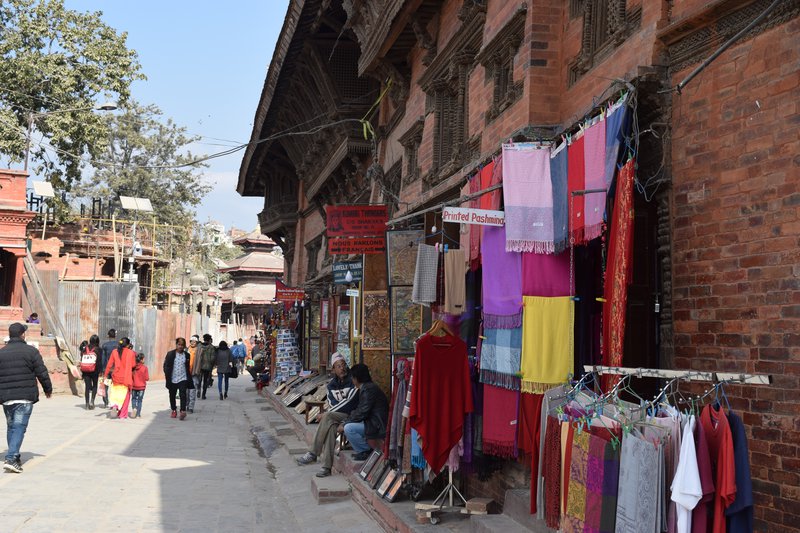
Spokesperson of Kathmandu Metropolitan City (KMC) Gyanendra Karki, however, holds the view that KMC is putting its efforts to beautify Ranipokhari with the temple after around 360 years.
As there appear many controversies and disputes, the pace of reconstruction of the ravaged heritage sites has not even begun. KMC blamed Department of Archaeology, community, and experts as creating an obstruction in reconstruction work.
“The government has prioritized reconstruction of heritage sites, but the archaeology department has not given its clearance for the same. That’s why the reconstruction of monuments has not begun,” said KMC Spokesperson Gyanendra Karki.
According to Karki, KMC’s budget for the fiscal 2074-75 has also given priority for reconstruction of heritage sites. Despite this, reconstruction work has not picked up the pace. This is a cause for concern.
Karki says they will expedite reconstruction work once the department gives its nod. Karki points that a nod from the archaeology department is mandatory before starting reconstruction of heritage sites in Kathmandu metropolis.
“The living culture of the Kathmandu Valley is a source of pride and identity, and a vital source of revenue, for the entire country. If it is to survive, there has to be a presumption that local communities will be involved in heritage preservation and that traditional artisans and techniques will be employed to reconstruct key sites. What has particularly raised the ire of the activists who padlocked the site in protest is the insensitive use of concrete, both to build the boundary wall and to line the pond, when alternative traditional techniques are easily available,” writes David Gellner, Professor of Social Anthropology, and University of Oxford, UK in his article in The Kathmandu Post..
“The controversy over the rebuilding of, and opening access to, Ranipokhari may become a case study in the handling of significant cultural heritage in Kathmandu. It may also become a case study in the kinds of conflict that are likely to arise under the new governance structures that Nepal is going to have to get used to operating over the coming years. Let us hope that it is not held up in future as an example of how not to do conservation,” says Gellner.
Complex Controversy
KMC was also involved in another controversy permitting the construction of a commercial complex at the entry gate of Hanumandhoka Palace by Maharjan Business Association Pvt. Ltd.
Following the damage caused by an earthquake, Maharjan Business Associates bought 627, 98 square kilometers of land and property from Crystal Hotel group hoping to build a grand commercial complex at the heart of New Road.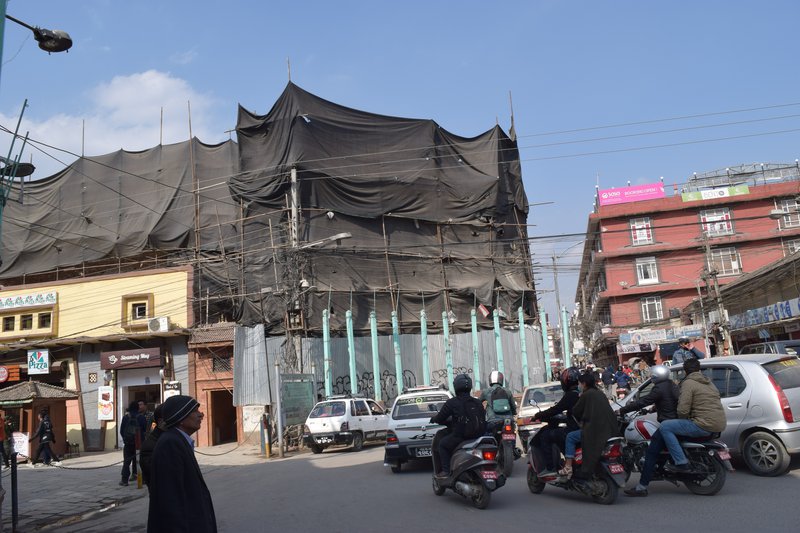
Maharjan Business Associate secured the permission from KMC and Department of Archeology for three stories complex with the height of 9’-4” basement, 10’-5” ground floor and 10’5” first floor. However, the company added an additional floor and KMC officials issued permits to them.
As per Heritage Preservation Act and Regulation, there is a restriction of heights of the building not exceeding 35 feet and there is a restriction for the basement as well in the areas.
However, Maharjan Business Associates secured permission from KMC for construction of 4+ including the basement without recommendation of criteria of Department of Archeology.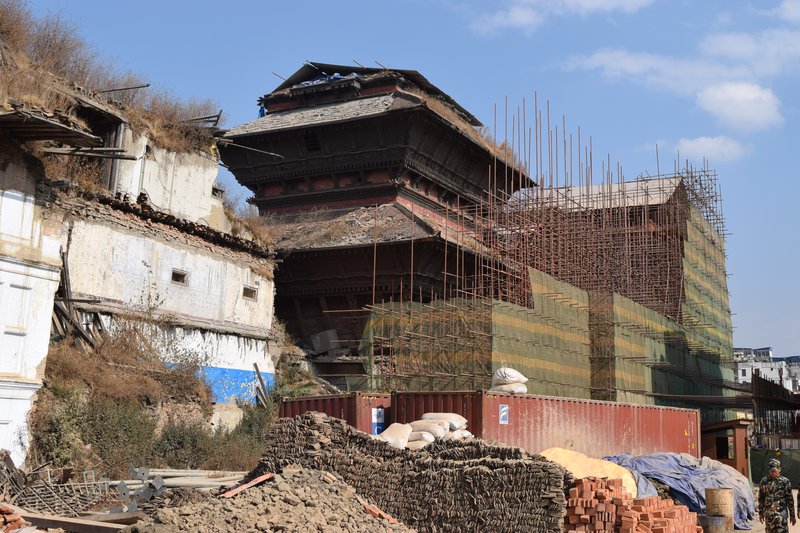
“We found that KMC’s engineers and staffs unilaterally issued the permission to Business Associates. We also found some forgery document,” said Ganapati Lal Shrestha, a save heritage activist.
Following opposition of local people, KMC issued orders to stop all construction activities. “We are not saying that the business associates cannot construct the house but our point is that it should be as per the law and regulations,” said Shrestha.
After the controversy, the promoter of the complex reportedly assured Department of Archeology that they will withdraw the plan to erect another floor and demolish the structures.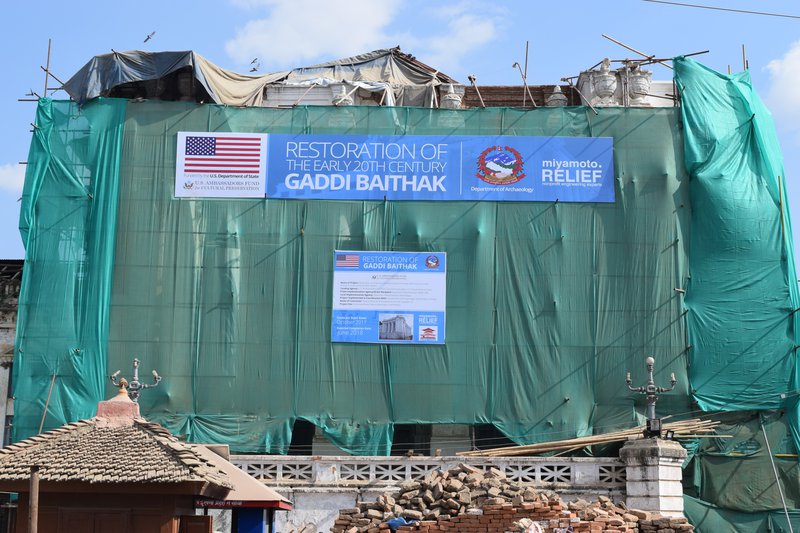
As the local community has already filed complaints in the Commission of Investigation of Abuse of Authority demanding action against those employees of KMC, the fate of the complex is now in limbo.
UNECO In Housing Controversy
Following the protest from local community regarding its letter justifying the illegal construction at Hanumandhoka, UNESCO clarified its stand.
“In the case mentioned by the reports, UNESCO was informed at a late stage when the basement structure had already been excavated. UNESCO therefore immediately transmitted the information to the Department of Archaeology and secretary at the Ministry of Culture, and as the construction was already advancing, it drew the attention of the building owner to existing regulations,” read a press release issued by UNESCO.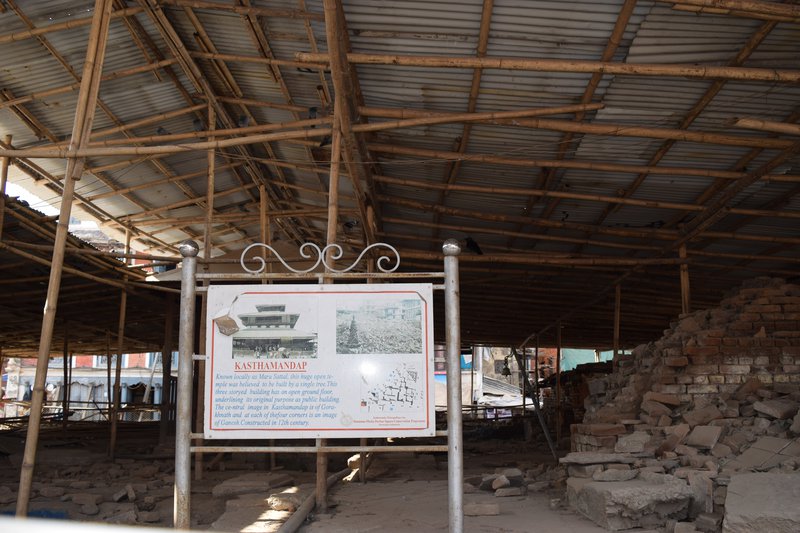
“UNESCO then examined if this construction presented any adverse impact to the outstanding universal values of the Hanumandhoka World Heritage site.
The plans of a four-story building, which we were shown, seemed to respect the authorized height and its design matched better than the previous concrete building with the historic environment,” it added.
UNESCO, however, urged the concerned authorities to investigate and take actions as necessary. According to the release, UNESCO is a keen advocate for the preservation of Nepal’s cultural heritage and, jointly with Department of Archaeology, is carrying out many projects for post-earthquake restoration of cultural heritage.
Although the construction of the complex, has been halted following an order by Kathmandu Metropolitan City on November 24, 2017, efforts are on to justify the constructions.
Dharahara Reconstruction
Although National Reconstruction Authority, Department of Archeology and Kathmandu Metropolitan City have announced that the reconstruction of Dharahara will begin within a few months, things are not going to be easy.
As KMC leased out to Sidewalker’s Traders Pvt Ltd, a private company for twenty years in 2006, the company hints that they will withdraw from the place only after receiving due compensation.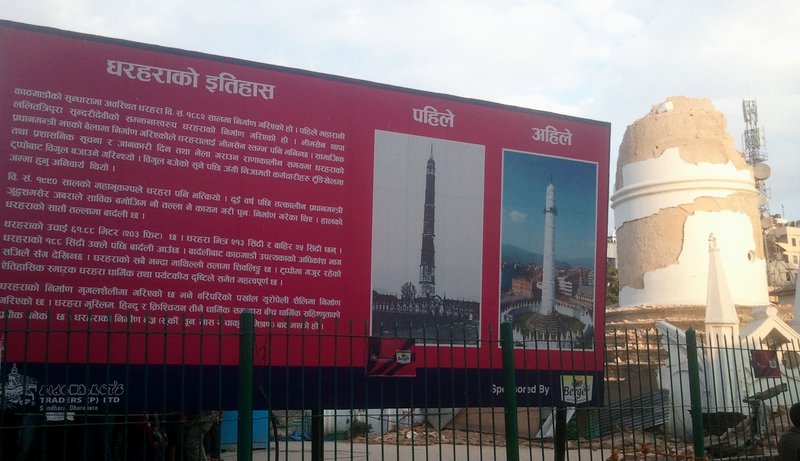
Sidewalker’s Traders Pvt Ltd has been running a fast-food restaurant at the site and has also been leasing other 18 fancy shops. As the future of its contract is uncertain, it has not made any payment to Kathmandu Metropolitan City for the last 18 months, with the due amount now reaching Rs 4.6 million.
Despite the bitter experience with Dharahara in leasing out public place, KMC is pursuing a similar model for Ranipokhari. “With the available record, what we can say is that a politically powerful group is behind the leasing of all public spaces including Ranipokharai,” said Ganapati Lal Shrestha.
Bag Durbar Controversy
Although Department of Archeology objected to demolishing Bag Durbar, a historical and archeological site, KMC had decided to pull down the old building and construct a, ten storied, new one.
Defending his decision, mayor Shakya has said that KMC has already prepared a design of the new building and they will build as per the design despite the opposition from Department of Archeology.
“Who is this Department of Archeology to guide us on each and every issue? KMC is an elected body with authority derived from law and construction,” said Shakya. “We will dismantle old Baghdurbar which is not fit to live in even after retrofitting.”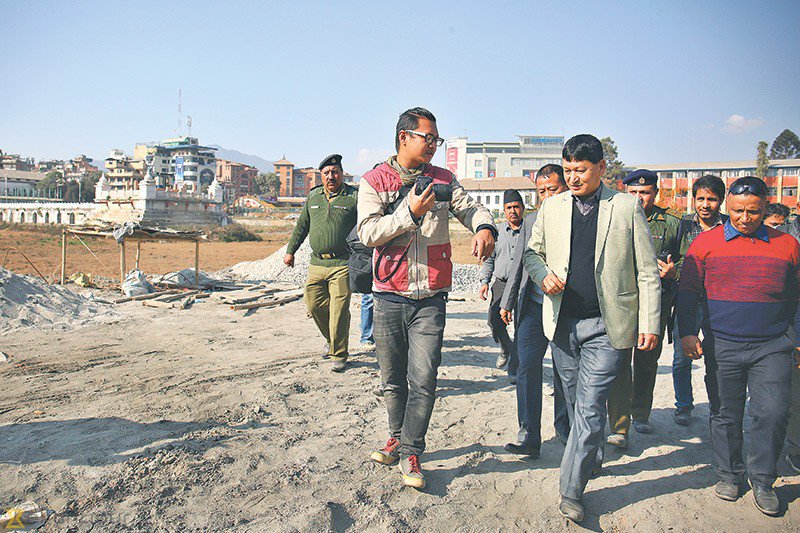
However, Department of Archeology has suggested KMC strengthen the existing building as per the need. The Department has clearly issued a direction to KMC not to add new structures and adhere to archaeology and technology of Rana times.
“I will assure people that reconstruction of all heritage sites including Ranipokhari, Dharahara and Kasthmandap will start shortly. The mission to complete reconstruction will require dedication and commitment from all. If all stakeholders work together giving up Lovani and Papani (Greed and Sin), we will complete the reconstruction of all the heritage sites,” Yubaraj Bhusal said to New Spotlight. “We will achieve our target.”
Political Tussle
After vehement opposition from archeologists, local community and people from all walks of life, cracks have developed in political parties and KMC. The dispute over the under-construction Ranipokhari has turned now into a political tussle.
Deputy Mayor of Kathmandu Metropolitan City Hari Prabha Khadgi rebelled against Mayor Shakya. “I will put all my effort to stop the ongoing reconstruction of Ranipokhari. I was told that reconstruction of Ranipokhari would be carried out using traditional skills, but I realize now that it was not true. I was kept in the dark. Now I will do everything in my power to halt the work,” said Khadgi.
“We will oppose KMC’s monopoly and hereby ask the mayor to respect the verdict of the people,” said Defense Minister and Member of Parliament from Kathmandu Constituency No 6 Bhimsen Das Pradhan. Minister Pradhan and Deputy Mayor Khadgi were elected to their respective offices from Nepali Congress.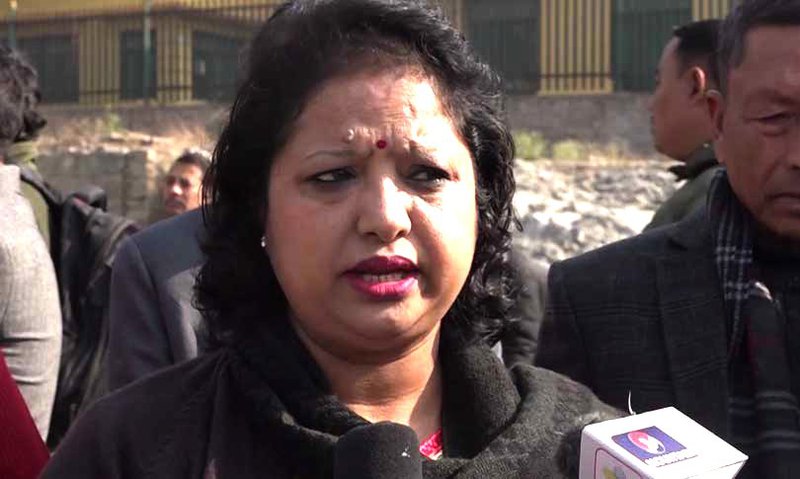
Despite the protests, KMC does not seem to be in a mood to stop its plan. Mayor Shakya said, “These people are creating obstacles to the development process and KMC will not give in. After recommendation of the committee, we will resume our work. Heritages are public property and we don’t want any unnecessary disputes hindering the reconstruction. We have made some minor changes but reconstruction will be carried out as per the DOA sanctioned design.”
“We will build a water fountain in Ranipokhari and conserve and develop the pond as an exotic and beautiful park,” Shakya said, “If things pan out as per the plan, we want to connect Ranipokhari with Ratna Park through an alternative route.”
Downplaying the objection put forth by archeologists that concrete was being used during the reconstruction, Shakya said, we have to conserve the heritage as per the demand of changing times.
Local Level Roles In Question
As per the Constitution of Nepal 2015 and Local Government Operation Act, 2074 (2017), the local levels are given the role to preserve and protect the heritage sites and open public land.
According to the act, one of the basic obligations of locals is to work, preserve and protect the heritage sites and support the provincial and central government to maintain them.
Given the recent activities of KMC in preserving the heritage sites, what one can draw is the conclusion that Nepal’s public space, including heritage sites, are not safe. For almost fifteen years, people hoped that the elected representatives at a local level would bring the changes and protect the heritage and public property.
With the involvement of elected representatives in various scandals in a demolition of heritage sites and leasing the public property to fulfill vested interests, the message has already gone wrong.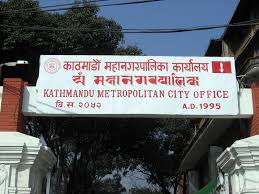
It reveals a nexus of politicians, elected representatives, and land mafias is threatening Nepal’s public property with personalization.
Given KMC’s controversial decisions, politicization and involvement of people with profit interest and resistance from the community, the reconstruction of heritage sites in Kathmandu will take a long period of time.
Reconstruction of heritage is possible only through better coordination among different stakeholders, including local level, community, and government. Consultation with the community will also make reconstruction accountable.
Interviews
“Procedures Delaying Some Reconstruction” Bhesh Narayan Dahal
As controversies rage over heritage reconstruction, Bhesh Narayan Dahal, Director General of Department of Archeology, spoke to New Spotlight on various issues. Excerpts: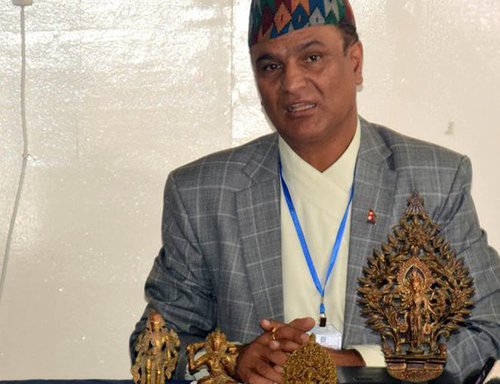
Why is the process of reconstruction of heritage sites getting delayed in Hanumandhoka Palace?
I don’t agree the reconstruction going on in many heritage sites is getting delayed. Of course, there are delays in some sites because of the opposition from the local communities on the procedural issues of construction. As the Department of Archeology is a government institution, it needs to abide by the existing laws and regulations. According to the Procurement Act and Procurement Regulations, we need to call an open tender for construction involving any amount. However, the local communities are opposing this process and demanding the work be done on daily payment basis. As a government official, I cannot go against the existing laws. This is also delaying the process of reconstruction.
What about the state of Kasthamandap?
So far as Kasthamandap is concerned, the construction was delayed because of the difference between the local communities and Kathmandu Metropolitan City. As a heritage built in the seventh century, Kasthamandap has its own historical and cultural values. We have already prepared the drawing and design. We have handed over the cost estimate of 190 million rupees for the Kathmandu Metropolitan City. As more than 60 different community institutions are involved and they are not listening to one another. As differences of opinion prevail, the reconstruction of Kasthamandap is also not taking speed.
How about the dispute in Ranipokhari?
So far as the reconstruction of Ranipokhari is concerned, the department has handed over an approved design for beautification to Kathmandu Metropolitan City. As KMC is going against the design given by us, we are compelled to halt the process of reconstruction. Following the controversy on the design presented by KMC, a high-level committee of experts was formed under the former Director General of our department with other renowned experts and members of the local community. Once the committee submits its report, the reconstruction will start in its old shape. Due to all these reasons, the pace of reconstruction of heritage sites in Kathmandu is getting delayed.
How about Patan and Bhaktapur?
The progress in Patan and Bhaktapur is fast as the local communities and local levels are working together. They are cooperating with the department as well. We have an understanding with Bhaktapur Municipality on the reconstruction modalities of temples and we have divided the temple reconstruction with consent. With a better coordination among us, we are reconstructing the temples and heritage sites in Bhaktapur. We have already reconstructed eight heritage sites. We have a future plan to go ahead on full steam.
What about Patan?
Under the leadership of Kathmandu Valley Preservation Trust and its Executive Director Dr. Rohit Ranjit, local community, local level and department are working together to reconstruct many temples. With the permission and norms of Department of Archeology, Kathmandu Valley Preservation Trust has already completed reconstruction of several heritage sites. There is no opposition and dispute in Patan. Reconstruction of Manimandap is in the final stage. Within one and half months, reconstruction of Krishnamandir is also going to be complete. Taleju Temple and Sundarichwok reconstruction have already completed.
How about other places?
Except for Hanumandhoka, we have completed the reconstruction of several other heritage sites, including the retrofitting of Changunarayan Temple. I am proud to say that the department has completed the retrofitting without support from foreign countries. As our slogan is to build back better, we have completed other projects as well. The Anantapur Tower of Swayambhu has already seen ninety percent work done. Similarly, the reconstruction of heritage sites of Nuwakot, Gorkha and Sindhupalchwok are making progress. Of course, the progress in Kathmandu is slow but the reconstruction of heritage sites in other districts has made good progress. Despite certain problems and disputes, we have completed several other heritage sites including the roof of Taleju, Nangarhar and others. Gaddibaithak is under construction through US support, Nautale Durbar by the Chinese government and Agam Chhe under Japanese support.
As Kathmandu’s heritage sites are situated in the prime commercial locations, don’t you see there are vested interests involved in the reconstruction and encroachment of heritage land?
There are disputes on the reconstruction of some of the heritage sites which were rented by Guthi Sansthan to shopkeepers. As they have rented the shops at a minimum price, they want to keep it that way. In some commercial areas, one can see vested interests also delaying the reconstruction. We have settled this issue in the old district court of Patan.
Are your recommendation and instruction mandatory in the construction of private houses and reconstruction of heritage sites?
The recommendation of Department of Archeology is mandatory for construction and reconstruction of any temple or heritage site. However, there are other authorities to implement our guidelines. Kathmandu Metropolitan City and Kathmandu Valley Town Planning Authority are implementing agencies. We have to depend on other agencies for implementation of our order. We don’t have the manpower to dismantle the houses built violating heritage sites directives. I have to accept the fact that we are unable to implement many of our decisions because of all these handicaps.
“Only People Power Will Save Our Heritage” Ganpatilal Shrestha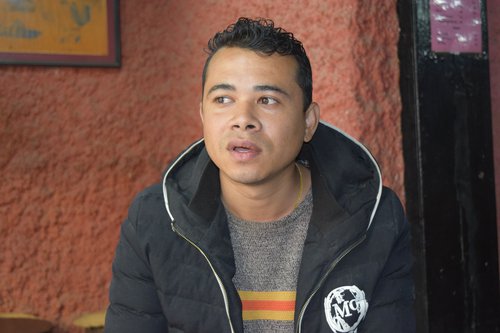
Although he is just 29 years old, Ganpatilal Shrestha, an activist of Save Kathmandu Campaign, has been fighting to save the heritage sites of Kathmandu. With the initiative of his group, the activists of Save Kathmandu Heritage are able to stop the illegal construction of houses in heritage areas. He is now battling with the Kathmandu Municipal City authorities regarding the construction of a building by Maharjan Business Associates Pvt. Ltd. Shrestha spoke to New Spotlight. Excerpts:
What is the purpose of your group?
We have been waging a war against those who work illegally to destroy our heritage sites. Our struggle is not personal, it is directed to save our heritage sites. Given the present situation when elected representatives are also working for personal gains, only the voice and ownership of community can save our heritage. If we fall asleep, politicians will sell out our heritage. Destruction of Ranipokhari in the name of beautification and allowing illegal construction for private parties at the eastern entry point of Hanumandhoka are two good examples. We realize that when an elected representative of institutions like Kathmandu Metropolitan City, KMC, undermine the law, nothing can save our heritage without the people’s power.
How do you save them?
We are fighting the legal battle. We file complaints at Department of Archeology, Commission of Investigation of Abuse of Authority and other relevant ministries when KMC does not respond to our complaint on the illegal construction of buildings while it is violating the order and direction of archeology department for a business group.
Instead of complaining to KMC, why do you go to other offices?
We filed our first complaint with KMC but they ignored our complaint. Our impression of service delivery institutions is very poor as they are taking the bribe to turn illegal work legal. There is rampant corruption in institutions like KMC. As the capital of Nepal, Kathmandu has been under rampant politicization as well. In Bhaktapur and Lalitpur, they have experts and masons to build the temples. This is lacking in Kathmandu.
Why did you oppose the contract system?
Since contract system has many loopholes, the authorities award contract on the basis of manipulation, muscle, and money. Because of all these, the quality of construction made under contract award is always poor. Frankly speaking, there is organized a syndicate of mafias involved in this. You can find mafia among the employees and politicians. We are demanding that all the temples should be reconstructed through daily wages, not on contract. We believe that the important part is heritage, not a concrete temple. The reconstruction should be made through the participation of people.
Why do you say, point blank, that there is involvement of corruption and mafia?
We have evidence to prove our accusation. For instance, KMC allowed Maharjan Business Associates Pvt. Ltd to construct the building against the approved design. Despite our complaints and several warnings of Department of Archeology, business was allowed to continue construction by KMC and KVTDA. There is rampant corruption in KMC’s design approval division. KMC also works under the political influence as well. When all our efforts failed, we moved CIAA.
Why is there a delay in reconstruction of Kasthamandap?
So far as Kasthamandap reconstruction is concerned, the community should be given responsibility to reconstruct it not contractors. Ganesh Temple of Maru was rebuilt with the community support. If Nepal government calls for support, Nepalese will provide all resources to reconstruct the heritage sites. We are ready to contribute. We want municipality to allocate the budget and Department of Archeology to provide expertise.
How is your experience with the elected representatives?
It is unfortunate that our elected representatives failed to understand our values and heritage. Many foreigners visit Nepal to see it. In the name of commercialization, our leaders are destroying our heritage. We have lost our trust. You can see how they are trying to sell out our important heritage site, Ranipokhari, in the name of commercialization. There are so many coffee shops around the Ranipokhari, why do we need another coffee shop inside Ranipokhari? All are lured by money as the Ranipokhari occupies a prime land of Kathmandu where the land is priceless.
What about municipality and KVTDA ?
A business group is developing a business complex at the entry gate of Hanumandhoka violating all the laws, norms and regulations. It is unfortunate to say that the institutions like KMC and Kathmandu Valley Town Development Authority did not take any action even as it built basement next to world heritage sites. The business company violated all the rules and erected the building up to the third floor. No one takes actions. Despite frequent opposition from Department of Archeology, KMC allowed the illegal construction. It is unfortunate to say that even the institution like UNESCO is backing the illegal construction in heritage sites. Although they corrected their stand in the second press release, UNESCO supported the building construction in the first letter.
Why so?
There is a hidden nexus between KMC officials and business group. The building is constructed with intention. Although Maharjan Business group signed the agreement saying that it built just 35 feet high building, they are building much higher, luring concerned officials. Even a high-level technical team recommended that the building violated the rules and is liable for demolition. However, no one is taking action. They challenging the state. Even high officials of KMC are defending the illegal construction. Even Kathmandu Town Planning Authority has changed its stand. They are interpreting the laws in their own way. The building is against all the designs approved by KMC.
How about the political parties?
Five parties supported us. Despite huge pressure from local communities, nobody is taking action. There is corruption. We found several forged documents in KMC. Our concern is to protect and preserve our heritage sites. We youth believe in the process. CIAA has already taken the files for investigation. Our study reveals that Ranipokhari reconstruction has a connection with the construction of old bus park, which is leased out by KMC to a private party for 100 years. Only after the water drained out in Ranipokhari, the bus park started reconstruction. It shows that there is some connection.
Don’t you get threats?
I am regularly threatened by various groups. More than 200 people come to us. We take a case if there is a legal validity. We also fought against the privatization of Hanumandhoka. We fought the case in Supreme Court. We are actively involved in the protection of our heritage. We believe in the rule of law. We have received the backing from all. So far as Ranipokhari is concerned, we will do and die to protect it. Mayor has surrendered to us.
What about Dharahara?
Dharahara was given to Sidewalker Company in a long-term lease by then-mayor in 2004. Leasing out a public property for decades in a throwaway prices started from that point. The idea to establish coffee shop inside Ranipokhari is a continuation of the idea promoted to commercialize property of heritage sites and make money out of them. Those who want to beautify Ranipokhari, changing its old face have a clear intention to sell it out. We are actively taking part to preserve Ranipokhari. Our struggle is to prevent setting the wrong precedent. In the case of Dharahara, the building is rented in throwaway prices. They are generating Rs. 2 million monthly and paying Rs. 200,000.00. There are 17 shutters. KMC gives them away at throwaway prices. Sidewalks is reaping all benefits.
How is this possible?
There is a connection of politicians and land mafias to destroy our heritage sites, which are situated in prime commercial areas. State officials are protecting the wrongdoers. There are many coffee shops in Durbarmarg, why do they need a coffee shop in Ranipokhari. There are huge commercial interests in the construction and destruction of heritage sites. Mayor of KMC and other senior officials openly challenge the authority. They ask money. There is a big vested interest involved. In Ranipokhari, there is a big corruption. KMC allocated 100 million rupees and contractor 60 million rupees. There is a sharing of 4 million rupees. In their estimate, KMC proposed to use tile in basement.
How do you see the reconstruction of heritage sides delayed in Kathmandu durbar square?
Had it been delayed in the past, we would have blamed the employees. Even almost nine months after the elections of local level, we have seen nothing drastically changing in Kathmandu. What we have seen is a further worsening situation. When elected representatives are following the direction of land brokers and middlemen, what can we expect? When elected representatives back the idea and plan of people with commercial interest to destroy our heritage sites, what can you expect? For instance, the case of Ranipokhari and illegal building construction in the east of Hanumandhoka by Maharjan Business Associates speaks volumes about elected representatives. The newly elected mayor has even openly declared that he will dismantle Bagdurbar.
"Reconstruction Will Pick Pace" Yam Lal Bhoosal
As controversies surround heritage reconstruction, Yam Lal Bhoosal, spokesperson of National Reconstruction Authority spoke to New Spotlight about the progress.
How do you see the pace of heritage reconstruction?
Looking through the progress made in heritage reconstruction, there are ample reasons to be satisfied with the current pace. There is the need to reconstruct 753 heritage sites destroyed by the earthquake. Out of this, the construction of 79 heritage sites has already been completed and reconstruction of 314 heritage sites is in progress. Out of these sites, some are in the state of completion and some are in somewhere in the middle of work. Given the progress report, we believe that the pace is taking now. As we have already called several meetings with different stakeholders, what I can say is that the pace will accelerate now.
Why is the reconstruction of heritage sites getting delayed?
There are many stakeholders involved. The reconstruction of the heritage site is a concern of the local community, local bodies, Department of Archeology and international community like UNESCO for world heritage sites. The reconstruction of heritage sites is very complicated as it needs to have the coordination with all stakeholders. It takes a certain time to develop a mechanism for the coordination. The unavailability of traditional construction materials and expert masons are also responsible for the delay in reconstruction. It took us almost a year to identify the places to bring the traditional construction materials to provide technical training for a mason to construct the heritage sites. Of course, there was a bit of delay in the initial stage. Given the current state of preparation and planning, what NRA can say is that the progress will accelerate now on.
Disputes are appearing on the reconstruction of Ranipokhari, Dharahara and other old Rana Palaces. How does NRA look at them?
So far as Ranipokhari is concerned, there are two sides. The reconstruction of Balgopaleshwor Temple, which is currently carried out by Department of Archaeology and reconstruction of the decoration of pond is carried out by Kathmandu Metropolitan City. There appears a dispute on both the issues. A high-level expert committee is formed now and it will submit its recommendation within fifteen days, that is, by last week of January. Along with other experts, secretary of National Reconstruction is also a member of the committee. So far as my information is concerned, the reconstruction of Ranipokhari and Balgopaleshwor Temple will start on the basis of recommendation given by the committee. I think reconstruction of Ranipokhari will start soon.
PDF 21-29.pdf
This publication has been supported by The Asia Foundation. The contents of this publication reflect the views of the publication reflect the views of the author(s), researcher (s), and contributing editor (s) and do not necessarily reflect the views of The Asia Foundation.

Rani Pokhari
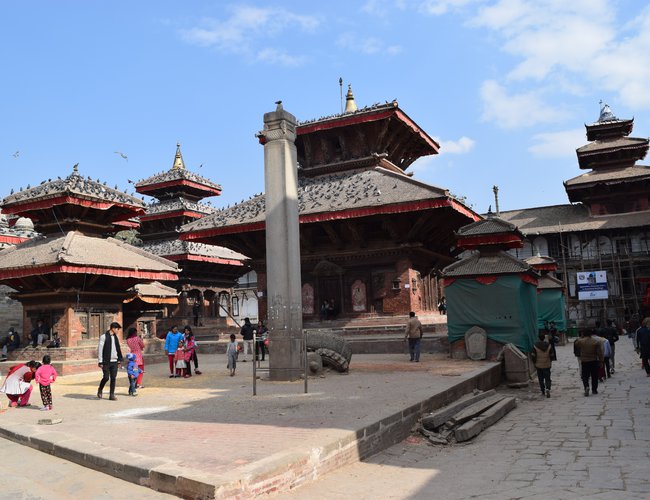

Keshab Poudel
Poudel is the editor of New Spotlight Magazine.
- IWMI: SoLAR Global Science-Policy Forum Conference
- Apr 25, 2024
- CLA: Samriddhi For Skill Development
- Apr 23, 2024
- ECONOMY: Growth At 3.3
- Apr 16, 2024
- DPM’s SHRESTHA’S CHINA VISIT High Profile, Low Key
- Apr 14, 2024
- Maha Kumbha In Barahkshetra: A Sacred Festival In Sacred Koshi (Kaushiki) River
- Apr 09, 2024

